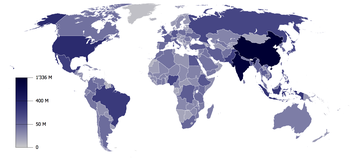Within the framework of WHO's definition of health as a state of complete physical, mental and social well-being, and not merely the absence of disease or infirmity, reproductive health, or sexual health/hygiene, addresses the reproductive processes, functions and system at all stages of life.[1] Reproductive health, therefore, implies that people are able to have a responsible, satisfying and safe sex life and that they have the capability to reproduce and the freedom to decide if, when and how often to do so. Implicit in this are the right of men and women to be informed of and to have access to safe, effective, affordable and acceptable methods of fertility regulation of their choice, and the right of access to appropriate health care services that will enable women to go safely through pregnancy and childbirth and provide couples with the best chance of having a healthy infant.
According to the WHO, "Reproductive and sexual ill-health accounts for 20% of the global burden of ill-health for women, and 14% for men."[2]
Childbearing and health
Waiting until mother is at least 18 years old before trying to have children improves maternal and child health.[3]
If an additional child is desired, it is considered healthier for mother, as well as for the succeeding child, to wait at least 2 years after previous birth before attempting to conceive (but not more than 5 years).[3] After a miscarriage or abortion, it is healthier to wait at least 6 months.[3]
International Conference on Population and Development (ICPD), 1994
The International Conference on Population and Development (ICPD) was held in Cairo, Egypt, from 5 to 13 September 1994. Delegations from 179 States took part in negotiations to finalize a Programme of Action on population and development for the next 20 years. Some 20,000 delegates from various governments, UN agencies, NGOs, and the media gathered for a discussion of a variety of population issues, including immigration, infant mortality, birth control, family planning, and the education of women.
The document[1] endorses a new strategy which emphasizes the numerous linkages between population and development and focuses on meeting the needs of individual women and men rather than on achieving demographic targets.
Key to this new approach is empowering women and providing them with more choices through expanded access to education and health services and promoting skill development and employment. The Programme advocates making family planning universally available by 2015, or sooner, as part of a broadened approach to reproductive health and rights, provides estimates of the levels of national resources and international assistance that will be required, and calls on Governments to make these resources available.
The Programme of Action includes goals in regard to education, especially for girls, and for the further reduction of infant, child and maternal mortality levels. It also addresses issues relating to population, the environment and consumption patterns; the family; internal and international migration; prevention and control of the HIV/AIDS pandemic; information, education and communication; and technology, research and development.



No comments:
Post a Comment